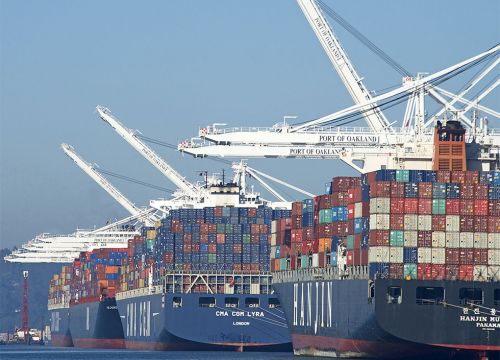How the Modern Day Shipping Container Changed the World

Feb. 23, 2017 -- For thousands of years, methods of shipping products across the seas and oceans remained essentially the same. Products came to port in wooden crates, sacks, and kegs by wagons or, later, by trucks and trains. Ships were then loaded and unloaded crate by crate, sack by sack, and keg by keg. It was a time-consuming and labor-intensive process. Theft was a perpetual problem. Often a ship spent more time in ports, loading and unloading, than it would spend at sea.
The advent of World War II brought new logistical challenges in supplying millions of U.S and allied troops overseas and innovative approaches were needed to efficiently supply the war effort. During this period, the introduction of small, standardized boxes full of war material increased the American convoys' capacity to deliver wartime necessities.
After the war, a trucking entrepreneur named Malcom McLean bought a shipping company and, in 1956, started the practice of transporting product-filled truck trailers that were lifted directly from truck to ship. Whole containers, not just small parcels, now moved efficiently onto ships. This transportation process, called intermodalism, allowed products to be shipped around the world quickly, cheaply, and efficiently by using cargo containers that more easily fit on trucks, trains, and ships.
The arrival of containers and intermodalism revolutionized the shipping industry. Containers could be efficiently stacked, allowing more and more goods transported across the seas. Labor costs dropped dramatically and, since containers were sealed, theft declined. Over time, the marine transportation industry and the size of ships, trucks, trains, docks, and ports increased and expanded to handle the growing use of containers. The impact on global commerce was enormous, leading to a boom in international trade due to lower transportation and handling costs.
As container ships continue to grow in size and ports grow more congested by the year, NOAA plays an increasingly critical role in U.S. marine transportation. NOAA services and products improve the efficiency of ports and harbors, promote safety, and help to ensure the protection of coastal marine resources. Today, NOAA's PORTS® system improves the safety and capability of maritime commerce through the integration of real-time environmental observations, forecasts, and other geospatial information. NOAA's Office of Coast Survey supplies electronic navigation charts, coast pilots, and navigation response teams to meet the increasing challenges associated with marine navigation. NOAA's National Weather Service provides up-to-date meteorological and oceanographic data. And, when there are spills, NOAA’s Office of Response and Restoration provides the science-based expertise and support needed to make informed decisions during emergency responses.
Read about some of our work in maritime emergency response:
On the Hunt for Shipping Containers Lost off California Coast
University of Washington Helps ITOPF and NOAA Analyze Emerging Risks in Marine Transportation
